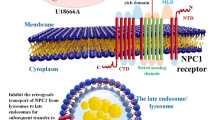Abstract
Alzheimer’s disease (AD) is a neurodegenerative disorder characterized by progressive memory deficit, cognitive impairment, and personality changes accompanied by specific structural abnormalities in the brain. Deposition of amyloid-β (Aβ) peptide into senile plaques is a consistent feature of the brains of patients affected by AD. Studies with both animal and cellular models of AD have shown that cholesterol homeostasis and distribution regulate Aβ generation. We have provided genetic, biochemical, and metabolic evidence that implicates intracellular cholesterol distribution, rather than total cholesterol levels, in the regulation of Aβ generation. This minireview focuses on the role of acyl-coenzyme A: cholesterol acyltransferase activity (ACAT) in Aβ generation. In genetically mutant cell lines that overproduce cholesterol but cannot synthesize cholesteryl esters (CEs) because of deficient ACAT activity, Aβ production is almost completely inhibited. Acyl-coenzyme A: cholesterol acyltransferase activity (ACAT) inhibitors, currently being developed for the treatment and prevention of atherosclerosis, reduce CE levels and Aβ generation by up to 50% in cell culture models of AD. Future mechanistic and transgenic animal studies are needed to evaluate the potential use of ACAT inhibitors in the therapeutic treatment or prevention of AD.
Similar content being viewed by others
References
Cadigan K. M., Heider J. G., and Chang T. Y. (1988) Isolation and characterization of Chinese hamster ovary cell mutants deficient in acyl-coenzyme A: cholesterol acyltransferase activity. J. Biol. Chem. 263, 274–282.
Chang T. Y., Chang C. C., and Cheng D. (1997) Acylcoenzyme A:cholesterol acyltransferase. Annu. Rev. Biochem. 66, 613–638.
Chang T. Y., Chang C. C., Lin S., Yu C., Li B. L., and Miyazaki A. (2001) Roles of acyl-coenzyme A:cholesterol acyltransferase-1 and -2. Curr. Opin. Lipidol. 12, 289–296.
Eckert G. P., Kirsch C., and Muller W. E. (2003) Brain-membrane cholesterol in Alzheimer’s disease. J. Nutr. Health Aging 7, 18–23.
Fassbender K., Simons M., Bergmann C., Stroick M., Lutjohann D., Keller P., et al. (2001) Simvastatin strongly reduces levels of Alzheimer’s disease beta-amyloid peptides Abeta 42 and Abeta 40 in vitro and in vivo. Proc. Natl. Acad. Sci. U. S. A. 98, 5856–5861.
Frears E. R., Stephens D. J., Walters C. E., Davies H., and Austen B. M. (1999) The role of cholesterol in the biosynthesis of beta-amyloid. Neuroreport 10, 1699–1705.
Hartmann T. (2001) Cholesterol, Abeta and Alzheimer’s disease. Trends Neurosci. 24, S45-S48.
Puglielli L., Konopka G., Pack-Chung E., Ingano L. A., Berezovska O., Hyman B. T., et al. (2001) Acyl-coenzyme A: cholesterol acyltransferase modulates the generation of the amyloid beta-peptide. Nat. Cell. Biol. 3, 905–912.
Puglielli L., Tanzi R. E., and Kovacs D. M. (2003) Alzheimer’s disease: the cholesterol connection. Nat. Neurosci. 6, 345–351.
Refolo L. M., Pappolla M. A., LaFrancois J., Malester B., Schmidt S. D., Thomas-Bryant T., et al. (2001) A cholesterol-lowering drug reduces beta-amyloid pathology in a transgenic mouse model of Alzheimer’s disease. Neurobiol. Dis. 8, 890–899.
Refolo L. M., Pappolla M. A., Malester B., LaFrancois J., Bryant-Thomas T., Wang R., et al. (2000) Hypercholesterolemia accelerates the Alzheimer’s amyloid pathology in a transgenic mouse model. Neurobiol. Dis. 7, 321–331.
Simons M., Keller P., De Strooper B., Beyreuther K., Dotti C. G., and Simons K. (1998) Cholesterol depletion inhibits the generation of β-amyloid in hippocampal neurons. Proc. Natl. Acad. Sci. U. S. A. 95, 6460–6464.
Tschape J. A., Hammerschmied C., Muhlig-Versen M., Athenstaedt K., Daum G., and Kretzschmar D. (2002) The neurodegeneration mutant lochrig interferes with cholesterol homeostasis and Appl processing. EMBO J. 21, 6367–6376.
Wollmer M. A., Streffer J. R., Tsolaki M., Grimaldi L. M., Lutjohann D., Thal D., et al. (2003) Genetic association of acyl-coenzyme A: cholesterol acyltransferase with cerebrospinal fluid cholesterol levels, brain amyloid load, and risk for Alzheimer’s disease. Mol. Psychiatry 8, 635–638.
Author information
Authors and Affiliations
Corresponding author
Rights and permissions
About this article
Cite this article
Puglielli, L., Ellis, B.C., Ingano, L.A.M. et al. Role of acyl-coenzyme A. J Mol Neurosci 24, 93–96 (2004). https://doi.org/10.1385/JMN:24:1:093
Issue Date:
DOI: https://doi.org/10.1385/JMN:24:1:093




